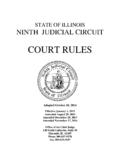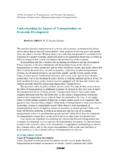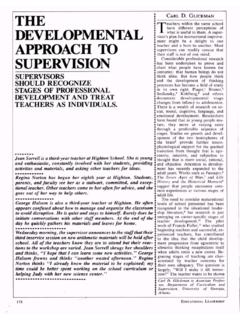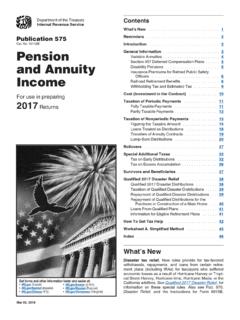Transcription of I. SECTION 457 DEFERRED COMPENSATION PLANS OF …
1 I. SECTION 457 DEFERRED COMPENSATION PLANS OF STATE AND LOCAL GOVERNMENT AND TAX-EXEMPT EMPLOYERS AFTER THE SMALL BUSINESS JOB PROTECTION ACT OF 1996 AND THE TAXPAYER RELIEF ACT OF 1997 by Cheryl Press and Robert Patchell 1. Introduction SECTION 457 PLANS are nonqualified, DEFERRED COMPENSATION PLANS established by state and local government and tax-exempt employers. These employers can establish either eligible (covered by 457(b)) or ineligible (covered by 457(f)) PLANS , and are subject to the specific requirements and deferral limitations of SECTION 457 of the Internal Revenue Code of 1986 ("Code"). Certain other types of PLANS established by state and local government and tax-exempt employers are not subject to the requirements of SECTION 457, however. The purpose of this article is to provide an overview of SECTION 457, identify the differences between an eligible and an ineligible SECTION 457 plan, and discuss those PLANS which are excepted from the rules and requirements articulated in SECTION 457 and the regulations thereunder.
2 This article will also try to highlight specific situations where PLANS may not be in compliance with SECTION 457. As originally enacted, the rules governing SECTION 457 PLANS were developed based on nonqualified plan concepts. SECTION 457 PLANS therefore are subject to different, and often less stringent regulations than are qualified PLANS , which must comply with complex rules to assure parity in who they cover, and how much can be DEFERRED . An attendant feature of SECTION 457 PLANS is that they may provide less security to participants than do qualified PLANS . Starting on January 1, 1997, important statutory changes to SECTION 457 resulting from the passage of 3448, THE SMALL BUSINESS JOB PROTECTION ACT OF 1996 ("SBJPA"), affect all eligible SECTION 457(b) PLANS , and, in particular, eligible SECTION 457(b) PLANS of state and local government employers. New SECTION 457(g) now requires that all amounts DEFERRED under eligible SECTION 457(b) PLANS of state and local government employers be set aside in trust for the exclusive benefit of plan participants.
3 This is in direct contrast to the law prior to the enactment of the SBJPA, which still subjects eligible SECTION 457(b) PLANS of tax-exempt employers to SECTION 457(b)(6) of the Code, and, therefore, still requires that they be unfunded. SECTION of this article provides a complete overview of this important requirement for government PLANS . This article will discuss, where appropriate throughout the article, the additional changes made to SECTION 457 under the SBJPA and more recently by SECTION 1071 of the Taxpayer Relief Act of 1997 ("TRA 97"). SECTION 457 PLANS Most recently, in Notice 98-8, 1998-4 6 (January, 1998) we issued substantive guidance concerning the revisions made to eligible SECTION 457(b) DEFERRED COMPENSATION PLANS by the SBJPA and the TRA 97. Specifically, Notice 98-8 provides guidance on the trust requirements applicable to state and local government employers maintaining a SECTION 457(b) plan, including the requirements for custodial accounts and annuity contracts; in-service distributions from a SECTION 457(b) plan if the total amount payable to the participant does not exceed $5,000; an additional election to defer commencement of distributions from a SECTION 457(b) plan and the cost of living adjustments to the $7,500 limitation on maximum deferrals under a SECTION 457(b) plan.
4 This article will discuss in detail these new changes to SECTION 457. Finally, this article updates SECTION 457 DEFERRED COMPENSATION Plan of State and Local Government and Tax-Exempt Employers, published in the Exempt Organizations Continuing Professional Education, Technical Instruction Program for FY 1997, Topic M, page 189. as well SECTION 457 DEFERRED COMPENSATION Plan of State and Local Government and Tax-Exempt Employers After the Small Business Job Protection Act of 1996 published in the Employee PLANS EP/EO CPE Technical Topics for 1997, Article No. 7, page 443. 2. SECTION 457(b) Eligible DEFERRED COMPENSATION PLANS SECTION 457(a) of the Code permits a participant to defer COMPENSATION to a DEFERRED COMPENSATION plan of an "eligible employer," provided that the plan satisfies the eligibility requirements of SECTION 457. Under SECTION 457(a), COMPENSATION DEFERRED pursuant to an eligible plan and the income attributable to such DEFERRED COMPENSATION , are taxable in the year in which the DEFERRED amounts are paid or made available to a plan participant or other beneficiary.
5 A. Eligible Employers An eligible DEFERRED COMPENSATION plan is defined as any plan, agreement or other arrangement that is established and maintained by an "eligible employer". Sections 457(b), 457(f)(3)(A). The term eligible employer is defined as a State (including the District of Columbia), political subdivision of a State, any agency or instrumentality of a State or political subdivision of a State, and any other organization (other than a government unit) exempt from tax under subtitle A of the Code. SECTION 457(e)(1), SECTION (c) of the Regulations. SECTION 457 therefore applies to all tax-exempt employers that maintain a DEFERRED COMPENSATION plan, except churches, which are specifically excluded under SECTION 457(e)(13). The application of SECTION 457 to DEFERRED COMPENSATION PLANS of exempt organizations became effective under the Tax Reform Act of 1986 ("TRA '86").
6 DEFERRED COMPENSATION PLANS of agencies and instrumentalities of the Federal Government are not subject to SECTION 457. 162 SECTION 457 PLANS B. Who May Participate in an Eligible Plan Under SECTION 457(b)(1)? (1) In General Only individuals who perform services for the entity, either as employees or independent contractors, may be participants in a SECTION 457 plan. SECTION 457(e)(2), (d). Corporations cannot be participants in a plan. (2) Select Group of Employees of Non-governmental Tax-exempt Entitites While any employee or independent contractor of a governmental entity can be a participant, tax-exempt organizations that are non-governmental must limit participation to management and highly compensated employees . This is because of the rules under Title I of the Employee Retirement Income Security Act of 1974 ("ERISA"), which are under the jurisdiction of the Department of Labor.
7 ERISA generally requires that a plan providing retirement benefits to employees must be funded by an irrevocable trust. SECTION 457 PLANS also provide such benefits. However, the rules of SECTION 457 require that such PLANS be unfunded in order to obtain tax benefits. Therefore, an entity cannot attain tax deferral for its employees under a SECTION 457 plan unless an exception to the funding requirement applies. Government PLANS are expressly exempt from the funding requirements of ERISA. Other tax-exempt employers may maintain SECTION 457 PLANS , but only for management and highly compensated employees, as the funding rules under ERISA do not apply to a "top hat" plan, a type of plan which specifically covers these types of employees. If the covered employees do not fall into these exceptions, the PLANS must be funded PLANS subject to the rules of ERISA. SECTION 457 PLANS are not subject to the nondiscrimination rules, with which funded, qualified PLANS must comply.
8 These rules are designed to insure that the highly compensated employees of an employer do not receive a disproportionate share of the benefits under qualified PLANS maintained by the employer. Neither the ERISA coverage rules nor the Code s coverage and nondiscrimination rules apply to unfunded top-hat PLANS , and no discrimination issue is raised by eliminating all rank and file employees from coverage under eligible 457 PLANS . In fact, SECTION 457 PLANS of tax-exempt employers must do just that in order to be eligible PLANS . In contrast, qualified PLANS are developed for the rank and file as well as for highly compensated employees. 163 SECTION 457 PLANS C. Maximum Deferral Limitations Under Sections 457(b)(2) and (3); Coordination Limitation Under SECTION 457 (c)(2) (1) General Rule; Cost-of-Living Adjustment Under SECTION 457(b)(2), a plan must provide that the annual amount that can be DEFERRED is limited to the lesser of $7,500, or 33 1/3 % of a participant s "includible COMPENSATION ".
9 The $7,500 limit includes both employer contributions and employee salary reduction deferrals. The SBJPA added SECTION 457(e)(15) which provides for A COST-OF-LIVING ADJUSTMENT (in $500 increments) of the maximum deferral amounts of $7,500 under sections 457(b)(2) AND (c)(1) at the same time and in the same manner as under SECTION 401(d), except that the base period is the calendar quarter ending September 30, 1994 and any increase which is not a multiple of $500 is rounded to the next lowest multiple of $500. The amendment is for taxable years beginning after December 31, 1996. For 1998, the deferral rate is $8,000. The maximum deferral amount for each year is announced before the beginning of the year at the same time as cost-of-living adjustments under SECTION 415(d), by the Employee PLANS Division of the Commissioner s office. The cost-of-living adjustment applies to the Coordination Limitation deferral amount referred to in SECTION 457(c)(1).
10 The cost-of-living adjustment does NOT apply to the $15,000 catch-up limitation of SECTION 457(b)(3), and any increase in the amount DEFERRED under SECTION 457(b)(2) will decrease the amount available under the catch-up permitted by SECTION 457(b)(3). (2) "Includible COMPENSATION " "Includible COMPENSATION " for a taxable year includes only COMPENSATION attributable to services performed for the employer which is currently included in the participant s gross income for the taxable year. Amounts DEFERRED (or otherwise not currently included in gross income) under SECTION 457 and other provisions of the Code are not part of "includible COMPENSATION ." SECTION 457(e)(5), SECTION (e)(2) of the Regulations. These other Code sections under which COMPENSATION is not includible in gross income include SECTION 401(k) cash or DEFERRED arrangements (CODAs or 401Ks), SECTION 402(h)(1)(B) simplified employee pensions (SEPs) and SECTION 403(b) tax-sheltered annuities (TSAs).
















